CHAPTER 12
The identified works of nine historical artists and two contemporary artists are featured.
|
Alice In Wonderland The Making of Alice In Wonderland Table of Contents: |
|
Alice In Wonderland The Making of Alice In Wonderland Table of Contents: |
|
CHAPTER XII - Alice's Evidence |
 Image: A.E. Jackson, 1915 |
`Here!' cried Alice, quite forgetting in the flurry of the moment how large she had grown in the last few minutes, and she jumped up in such a hurry that she tipped over the jury-box with the edge of her skirt, upsetting all the jurymen on to the heads of the crowd below, and there they lay sprawling about, reminding her very much of a globe of goldfish she had accidentally upset the week before. |
| `Oh, I BEG your pardon!' she exclaimed in a tone of great dismay, and began picking them up again as quickly as she could, for the accident of the goldfish kept running in her head, and she had a vague sort of idea that they must be collected at once and put back into the jury-box, or they would die. |  Image: Sir John Tenniel - 1865 |
`The trial cannot proceed,' said the King in a very grave voice, `until all the jurymen are back in their proper places-- ALL,' he repeated with great emphasis, looking hard at Alice as he said do.
Alice looked at the jury-box, and saw that, in her haste, she had put the Lizard in head downwards, and the poor little thing was waving its tail about in a melancholy way, being quite unable to move. She soon got it out again, and put it right; `not that it signifies much,' she said to herself; `I should think it would be QUITE as much use in the trial one way up as the other.'
As soon as the jury had a little recovered from the shock of being upset, and their slates and pencils had been found and handed back to them, they set to work very diligently to write out a history of the accident, all except the Lizard, who seemed too much overcome to do anything but sit with its mouth open, gazing up into the roof of the court.
`What do you know about this business?' the King said to Alice.
`Nothing,' said Alice.
`Nothing WHATEVER?' persisted the King.
`Nothing whatever,' said Alice.
`That's very important,' the King said, turning to the jury. They were just beginning to write this down on their slates, when the White Rabbit interrupted: `UNimportant, your Majesty means, of course,' he said in a very respectful tone, but frowning and making faces at him as he spoke.
`UNimportant, of course, I meant,' the King hastily said, and went on to himself in an undertone, `important--unimportant-- unimportant--important--' as if he were trying which word sounded best.
Some of the jury wrote it down `important,' and some `unimportant.' Alice could see this, as she was near enough to look over their slates; `but it doesn't matter a bit,' she thought to herself.
At this moment the King, who had been for some time busily writing in his note-book, cackled out `Silence!' and read out from his book, `Rule Forty-two. ALL PERSONS MORE THAN A MILE HIGH TO LEAVE THE COURT.'
Everybody looked at Alice.
`I'M not a mile high,' said Alice.
`You are,' said the King.
`Nearly two miles high,' added the Queen.
`Well, I shan't go, at any rate,' said Alice: `besides, that's not a regular rule: you invented it just now.'
`It's the oldest rule in the book,' said the King.
`Then it ought to be Number One,' said Alice.
The King turned pale, and shut his note-book hastily. `Consider your verdict,' he said to the jury, in a low, trembling voice.
`There's more evidence to come yet, please your Majesty,' said the White Rabbit, jumping up in a great hurry; `this paper has just been picked up.'
`What's in it?' said the Queen.
`I haven't opened it yet, said the White Rabbit, `but it seems to be a letter, written by the prisoner to--to somebody.'
`It must have been that,' said the King, `unless it was written to nobody, which isn't usual, you know.'
`Who is it directed to?' said one of the jurymen.
`It isn't directed at all,' said the White Rabbit; `in fact, there's nothing written on the OUTSIDE.' He unfolded the paper as he spoke, and added `It isn't a letter, after all: it's a set of verses.'
`Are they in the prisoner's handwriting?' asked another of they jurymen.
`No, they're not,' said the White Rabbit, `and that's the queerest thing about it.' (The jury all looked puzzled.)
`He must have imitated somebody else's hand,' said the King. (The jury all brightened up again.)
`Please your Majesty,' said the Knave, `I didn't write it, and they can't prove I did: there's no name signed at the end.'
`If you didn't sign it,' said the King, `that only makes the matter worse. You MUST have meant some mischief, or else you'd have signed your name like an honest man.'
There was a general clapping of hands at this: it was the first really clever thing the King had said that day.
`That PROVES his guilt,' said the Queen.
|
`It proves nothing of the sort!' said Alice. `Why, you don't even know what they're about!' `Read them,' said the King. The White Rabbit put on his spectacles. `Where shall I begin, please your Majesty?' he asked. `Begin at the beginning,' the King said gravely, `and go on till you come to the end: then stop.' |
 Image: Bessie Pease Gutmann, 1907 |
These were the verses the White Rabbit read:--
`They told me you had been to her,
And mentioned me to him:
She gave me a good character,
But said I could not swim.
He sent them word I had not gone
(We know it to be true):
If she should push the matter on,
What would become of you?
I gave her one, they gave him two,
You gave us three or more;
They all returned from him to you,
Though they were mine before.
If I or she should chance to be
Involved in this affair,
He trusts to you to set them free,
Exactly as we were.
My notion was that you had been
(Before she had this fit)
An obstacle that came between
Him, and ourselves, and it.
Don't let him know she liked them best,
For this must ever be
A secret, kept from all the rest,
Between yourself and me.'
 |
`That's the most important piece of evidence we've
heard yet,' `If any one of them can explain it,' said Alice,
(she had grown so large in the last few minutes that she wasn't a bit
afraid of interrupting him,) `I'll give him sixpence. I don't believe
there's an atom of meaning in it.'
|
`If there's no meaning in it,' said the King, `that saves a world of trouble, you know, as we needn't try to find any. And yet I don't know,' he went on, spreading out the verses on his knee, and looking at them with one eye; `I seem to see some meaning in them, after all. "--SAID I COULD NOT SWIM--" you can't swim, can you?' he added, turning to the Knave.
The Knave shook his head sadly. `Do I look like it?' he said. (Which he certainly did NOT, being made entirely of cardboard.)
`All right, so far,' said the King, and he went on muttering over the verses to himself: `"WE KNOW IT TO BE TRUE--" that's the jury, of course-- "I GAVE HER ONE, THEY GAVE HIM TWO--" why, that must be what he did with the tarts, you know--'
`But, it goes on "THEY ALL RETURNED FROM HIM TO YOU,"' said Alice.
`Why, there they are!' said the King triumphantly, pointing to the tarts on the table. `Nothing can be clearer than THAT. Then again--"BEFORE SHE HAD THIS FIT--" you never had fits, my dear, I think?' he said to the Queen.
`Never!' said the Queen furiously, throwing an inkstand at the Lizard as she spoke. (The unfortunate little Bill had left off writing on his slate with one finger, as he found it made no mark; but he now hastily began again, using the ink, that was trickling down his face, as long as it lasted.)
`Then the words don't FIT you,' said the King, looking round the court with a smile. There was a dead silence.
`It's a pun!' the King added in an offended tone, and everybody laughed, `Let the jury consider their verdict,' the King said, for about the twentieth time that day.
`No, no!' said the Queen. `Sentence first--verdict afterwards.'
`Stuff and nonsense!' said Alice loudly. `The idea of having the sentence first!'
`Hold your tongue!' said the Queen, turning purple.
`I won't!' said Alice.
`Off with her head!' the Queen shouted at the top of her voice. Nobody moved.
`Who cares for you?' said Alice, (she had grown to her full size by this time.) `You're nothing but a pack of cards!'
| At this the whole pack rose up into the air, and came flying down upon her: |  Image: A.E. Jackson, 1915 |
| she gave a little scream, half of fright and half of anger, |
 Image: Gwynedd M. Hudson, 1922 |
|
|
and tried to beat them off, and found herself....
|
...lying on the bank, with her head in the lap of her sister,
who was gently brushing away some dead leaves![]() that had fluttered down from the trees upon her face.
that had fluttered down from the trees upon her face.
`Wake up, Alice dear!' said her sister; `Why, what a long sleep you've had!'
`Oh, I've had such a curious dream!' said Alice, and she told her sister, as well as she could remember them, all these strange Adventures of hers that you have just been reading about; and when she had finished, her sister kissed her, and said, `It WAS a curious dream, dear, certainly: but now run in to your tea; it's getting late.' So Alice got up and ran off, thinking while she ran, as well she might, what a wonderful dream it had been.
But her sister sat still just as she left her, leaning her head on her hand, watching the setting sun, and thinking of little Alice and all her wonderful Adventures, till she too began dreaming after a fashion, and this was her dream:--
| First, she dreamed of little Alice herself, and once again the tiny hands were clasped upon her knee, and the bright eager eyes were looking up into hers--she could hear the very tones of her voice, and see that queer little toss of her head to keep back the wandering hair that WOULD always get into her eyes--and still as she listened, or seemed to listen, the whole place around her became alive the strange creatures of her little sister's dream. |  |
| The long grass rustled at her feet as the White Rabbit hurried by--the frightened Mouse splashed his way through the neighbouring pool--she could hear the rattle of the teacups as the March Hare and his friends shared their never-ending meal, and the shrill voice of the Queen ordering off her unfortunate guests to execution--once more the pig-baby was sneezing on the Duchess's knee, while plates and dishes crashed around it--once more the shriek of the Gryphon, the squeaking of the Lizard's slate-pencil, and the choking of the suppressed guinea-pigs, filled the air, mixed up with the distant sobs of the miserable Mock Turtle. |
|
| So she sat on, with closed eyes, and half believed herself in Wonderland, though she knew she had but to open them again, and all would change to dull reality--the grass would be only rustling in the wind, and the pool rippling to the waving of the reeds--the rattling teacups would change to tinkling sheep- bells, and the Queen's shrill cries to the voice of the shepherd boy--and the sneeze of the baby, the shriek of the Gryphon, and all thy other queer noises, would change (she knew) to the confused clamour of the busy farm-yard--while the lowing of the cattle in the distance would take the place of the Mock Turtle's heavy sobs. |  Image: Inset-Lewis Carroll |
| Lastly, she pictured to herself how this same little sister of hers would, in the after-time, be herself a grown woman; and how she would keep, through all her riper years, the simple and loving heart of her childhood: and how she would gather about her other little children, and make THEIR eyes bright and eager with many a strange tale, perhaps even with the dream of Wonderland of long ago: and how she would feel with all their simple sorrows, and find a pleasure in all their simple joys, remembering her own child-life, and the happy summer days. |  Image: Sir John Tenniel - 1865 1890 Nursery Version |
THE END
BEDTIME-STORY CLASSIC: Alice In Wonderland
(c) BEDTIME-STORY CLASSICS ILLUSTRATED
EDITION 1999 - TEXT FROM GUTENBERG/DUNCAN MILLENNIUM FULCRUM 2.7a - 1991
|
THE MAKING OF ALICE IN WONDERLAND |
About the Author:
Rev. Charles Lutwidge Dodgson, third of eleven
children of an Anglican priest, was a mathematician and a logician
who was a lecturer at Oxford for some 26 years. He was also an accomplished
photographer, and a Church Deacon. Dodgson's pen name, (and the
name by which you will undoubtedly know him best), was Lewis
Carroll. He is best known for his whimsical tales, Alice's
Adventures in Wonderland and Through the Looking Glass.
|
 Lewis Carroll - 1832-1898 Rev. Charles Lutwidge Dodgson |
Dodgson wrote four versions of "Alice".
Dodgson first told the story during a pleasant summer outing with friends. Reverend Dodgson, along with a Christ Church colleague, Robinson Duckworth, and the three young daughters of the Dean of Christ Church at Oxford, (Alice, Lorina, and Edith Liddell), in a rowing boat hired from Salter's boatyard, near Folly Bridgehad all set out on a lazy, 2½ hour rowing trip down the river Isis to Godstow, that July 4th in 1862.
Dodgson entertained his fellow passengers with a story he created on the spur of the moment for 10 year old Alice. Alice and her sisters were enchanted with the tale, and Alice later pleaded with Carroll to commit the story to paper, which he did, but he did not complete it until until the following February.
In an article in the New York Times of April 4th 1928 Alice Liddell recalled that
"The beginning
of Alice was told to me one summer afternoon when the sun was so hot we
landed in the meadows down the river, deserting the boat to take refuge
in the only bit of shade to be found, which was under a newly made hayrick.
Here from all three of us, my sisters and myself, came the old petition,
'Tell us a story' and Mr. Dodgson began it.
Sometimes to tease us, Mr. Dodgson would stop and say suddenly, 'That's
all till next time.' 'Oh,' we would cry, 'it's not bedtime already!' and
he would go on. Another time the story would begin in the boat and Mr.
Dodgson would pretend to fall asleep in the middle, to our great dismay."
Robinson Duckworth also described this trip:
"I rowed stroke
and he rowed bow (the three little girls sat in the stern) ... and the
story was actually composed over my shoulder for the benefit of Alice
Liddell, who was acting as 'cox' of our gig ... I remember turning round
and saying, 'Dodgson, is this an extempore romance of yours?' And he replied,
'Yes, I'm inventing it as we go along.' "
Charles Dodgson himself also recalled that day and others that followed:
"Many a day
we rowed together on that quiet stream - the three little maidens and
I - and many a fairy tale had been extemporised for their benefit- ..
-yet none of these tales got written down: they lived and died, like summer
midges, each in its own golden afternoon until there came a day when,
as it chanced, one of the listeners petitioned that the tale might be
written down for her."
Quotes Courtesy Christ Church
|
This first manuscript, which was called Alice's Adventures under Ground is thought to have probably been destroyed in 1864 when, on November 26th 1864, Dodgson presented Alice Liddell with a more elaborate hand-printed second version (shown at right) which included 37 of his own illustrations as a Christmas present. The manuscript, entitled "Alice's Adventures Underground" was presented to Alice Liddell, inscribed as "A Christmas Gift to a Dear Child, in Memory of a Summer Day". Reverend Dodgson later showed the tale to his family and his friend George Macdonald, who urged him to publish it. He subsequently revised and expanded the tale to almost twice its length and this third version was published by Macmillan and Co. in London, on July 4th, 1865. Sir John Tenniel was the artist who agreed to illustrate the revised and expanded text which was now called Alice's Adventures in Wonderland. The edition of Alice's Adventures in Wonderland which was published in July was subsequently withdrawn. The illustrator was displeased at the poor quality of printing, which did not do justice to his illustrations. All but about 15 copies were successfully recalled and presumed destroyed. A new edition was published in November (but dated 1866). Preferring anonymity for this whimsical work, since he had a professional reputation for producing more serious tomes, Dodgson chose to use the nom de plume or "pen name" of Lewis Carroll on his work. |
Version four was a complete rewriting of the tale for very young children "from nought to five" which was brought out by Macmillan in 1889 with 20 of Tenniel's pictures enlarged and coloured.
In March 1885 Dodgson obtained the now married Alice Liddell Hargreaves' permission to allow Macmillan to publish a facsimile of the manuscript of Alice's Adventures under Ground; and this appeared on December 22nd 1886 in an edition of 5,000 copies.
 1884 Edition - Courtesy USC Rare Book Collection |
|
The story originally created to amuse young Alice enjoyed wide-spread popularity, even sparking a stage production and related toys. Carroll wrote a total of ten books, some for children, others on math and logic. In 1871 Carroll published Alice's further adventures in "Through the Looking-Glass, and What Alice Found There". The tales "Hunting the Snark" and "Sylvie and Bruno" were amongst his later works.
In addition to laudatory fame, Carroll and his work also drew the predictible cadre of jealous attackers. Detractors began searching for hidden meanings in his writings, (sparking debates that still rage today), to the point that Carroll sought to distance himself from the books.
In an 1876 letter to readers Carroll implored them to read "Wonderland" in the "spirit in which I have written it."
|
Dodgson never had the opportunity to create stories for children of his own. Although he lectured in mathematics at Oxford, Dodgson was a profound stutterer, as were six of his seven sisters, and neither he nor his sisters ever married. In the company of the children of his friends, however, Dodgson found emotional respite as well as an appreciative audience for his literary whimsey, and his stutter would lessen appreciably. The man who was described by one of his illustrators as "an interesting but erratic genius", and by another as "impossible!", died in 1898 at the age of 66. A detailed look at Dodgson is offered by the web
site of Christ
Church at Oxford. |
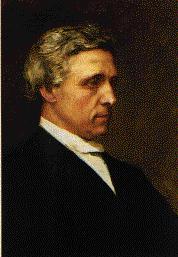 Charles Dodgson (Lewis Carroll) by Sir H. von Herkomer (posthumous portrait based on photographs) |
Illustrations:
 Lewis Carroll's OSTRICH 1862/ 1864 |
When Alice's Adventures Underground
gave way to the revised, extended version, which had been
renamed Alice's Adventures in Wonderland, the
artist chosen to illustrate it was Sir John Tenniel (b.
Feb. 28, 1820, London, Eng.--d. Feb. 25, 1914, London). The
first edition of that book was published in 1865. For example; In the original croquet
game sequence, "Alice's Adventures Underground"
had Alice using an Ostrich for a mallet. |
|
Sir John Tenniel 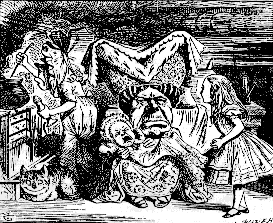 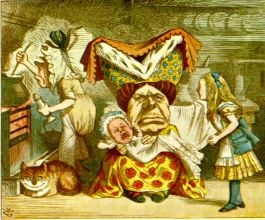
|
An English illustrator and satirical artist, Sir John Tenniel was especially known for political cartoons appearing in the British magazine, Punch. Today he is perhaps best remembered for his illustrations of Alice's Adventures in Wonderland (1865) and Through the Looking-Glass (1872). Tenniel's black and white illustrations (which
to this day remain the most famous) were for the reproductive
process known as wood-engraving. The book's cover described it as "Containing
Twenty Coloured Enargements From Tenniel's Illustrations to "Alice's
Adventures in Wonderland" With Text Adapted To Nursery Readers by
Lewis Carroll" . |
There have been any number of illustrators whose work has graced this popular tale over the years. The characters appearance tended to vary, according to each artists' style. In some cases, it's thought that more than one artist may have drawn Alice to resemble his own daughter. Regardless of artistic liberties taken, each set of illustrations was richly evocative of the tale, and each has contributed to our continued enjoyment of this story.
The works of several different illustrators have been selected for inclusion on the Alice In Wonderland story page. The varying styles offer a fascinating window into artistic creativity, allowing us to enjoy the historical as well as the contemporary illustrative renderings of this whimsical tale.
Of interest is the radical variation of certain scenes portrayed by each successve illustrator. Also of interest will be variations in Alice's clothing and hair. Details in some of the earlier illustrations are particularly extraordinary. Tea Party scenes, by both Rackham and Jackson, (Rackham to a greater degree of detail) show even the folds in the tablecloth, caused by it having been stored in a cupboard prior to the table being set.
Gutmann's rendering of the Frog footman is exquisite, and Rackham's Alice holding the pig-baby is remarkably poignant. The works of nine historical artists are currently displayed. The works of another two artists were chosen to represent more contemporary styles.
As additional resources for historical illustrations become available, more illustrations will be evaluated for addition to this tale. In addition to illustrations by the author and by Sir John Tennile, the following artists (listed adjacent to a representative sample of their work) have extensive works which appear on the story page. The listing is in chronological order.
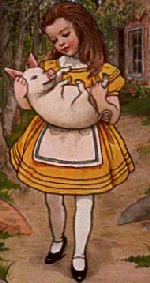
|
Kirk,
Maria L. New York: Stokes, 1904. This time there could be no mistake about it; it was neither more nor less than a pig. Courtesy Collection of Dave Neal |
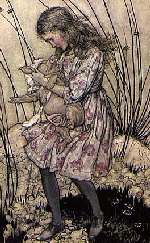
|
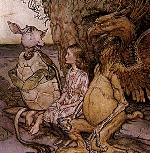  Arthur Rackham 1837-1939 |
Rackham,
Arthur. London: William Heinemann, 1907. (L) It grunted again so violently that she looked down into its face in some alarm. (R)The Mock Turtle drew a long breath and said: "That's very curious" Courtesy Collection of Dave Neal |
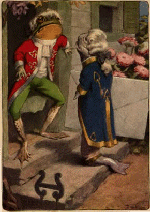
|

|
Gutmann,
Bessie Pease. New York: Dodge, 1907. (L) It was opened by another footman. (R) The Rabbit actually took a watch out of its pocket. Courtesy Collection of Dave Neal |

|
Attwell, Mabel Lucie. London: Raphael
Tuck & Sons, Ltd., 1910. Alice in the pool of tears. Courtesy Collection of Dave Neal |
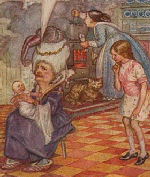
|
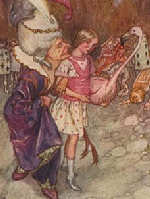
|
Jackson, A.E. New
York: Henry Frowde, 1914; London: Frowde, 1915. (L) "Please would you tell me," said Alice, a little timidly, "why your cat grins like that?" (R) She was exactly the right height to rest her chin on Alice's shoulder. Courtesy Collection of Dave Neal |
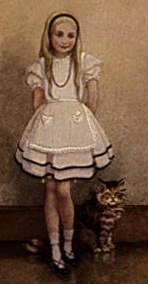
|
Hudson,
Gwynedd M. London: Hodder, 1922; New York: Dodd, 1922. Alice and Dinah Courtesy Collection of Dave Neal |
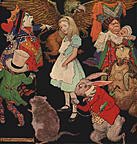 |
Jessie Willcox Smith
- Collage from Boys and Girls of Bookland. Smith, Nora Archibald, 1923 Courtesy of Athens Antique Labels & Prints : oldlabel@sover.net |
| Other early Illustrators
whose works are not yet pictured: Newell, Peter. New York and London: Harper and Brothers, 1901. Soper, George. London: Headley, 1911; New York: Baker, 1911. Sowerby, Millicent. London:Chatto and Windus, 1907. Tarrant, Margaret W. London: Ward, Lock and Co. Ltd., 1916. Walker, W.H. London: John Lane, 1907. Woodward, Alice B. London: G. Bell, 1913. Please tell us if you have additional resources. |
 |
CONTEMPORARY ARTWORK: Outside
of the Disney characters, which have become so much a part of the childhood
memory of the last several generations, the only other contemporary
artist whose illustrations were chosen to be featured on this tale is
Marshall Vandruff, who has himself
produced all new artwork for Alice In Wonderland. Marshall's delightfully
surreal, hookah-smoking Caterpillar was singularly ideal, and met the
tone set by Carroll for the dialogue. Marshall Vandruff's client list includes MAD Magazine, Hanna Barbera, Warner Brothers, and many others. |
 Down the Rabbit Hole. This spectacular vertical image from Disney's movie, "Alice in Wonderland" is a framed, Limited Edition print, which measures 18" x 38". Appears Courtesy of American Royal Arts . |
From Disney's Animated Version, all
animation images are Copyright Disney.
Alice, the Cheshire cat, and the rest of Carroll's marvelous characters were popularized again in the 20th century by the masters of animation at the Disney studios. The 1951 Disney movie version of Alice In Wonderland (now available on video) borrowed elements from more than one of Carroll's tales, however. Walt Disney's Alice in Wonderland is based on both
Carroll's Alice's Adventures in Wonderland, and the subsequent book,
Through the Looking Glass, and What Alice Found There.
|
| Note from the
Author, Lewis Carroll, appended to the Nursery
edition published at Easter in the year 1890. An Easter Greeting to Every Child Who Loves "Alice" My, Dear Child, Do you know that delicious dreamy feeling, when one first wakes on a summer morning, with the twitter of birds in the air, and the fresh breeze coming in at the open window--when, lying lazily with eyes half shut, one sees as in a dream green boughs waving, or waters rippling in a golden light? It is a pleasure very near to sadness, bringing tears to one's eyes like a beautiful picture or poem. And is not that a Mother's gentle hand that undraws your curtains, and a Mother's sweet voice that summons you to rise? To rise and forget, in the bright sunlight, the ugly dreams that frightened you so when all was dark--to rise and enjoy another happy day, first kneeling to thank that unseen Friend who sends you the beautiful sun? Are these strange words from a writer of such tales
as "Alice"? And is this a strange letter to find in a book
of nonsense? It may be so. Some perhaps may blame me for thus mixing
together things grave and gay; others may smile and think it odd that
any one should speak of solemn things at all, except in Church and
on a Sunday: but I think--nay, I am sure--that some children will
read this gently and lovingly, and in the spirit in which I have written For I do not believe God means us thus to divide
life into two halves--to wear a grave face on Sunday, and to think
it out-of-place to even so much as to mention Him on a week-day. Do
you think He cares to see only kneeling figures and to hear only tones
of prayer--and that He does not also love to see the lambs leaping
in the sunlight, and to hear the merry voices of the children, as
they roll among the hay? Surely their innocent laughter is as sweet
in his ears as the grandest anthem that ever rolled up from the "dim
religious light" of some solemn And if I have written anything to add to those stores of innocent and healthy amusement that are laid up in books for the children I love so well, it is surely something I may hope to look back upon without shame and sorrow (as how much of life must then be recalled!) when my turn comes to walk through the valley of shadows. This Easter sun will rise on you, dear child, "feeling your life in every limb," and eager to rush out into the fresh morning air--and many an Easter-day will come and go, before it finds you feeble and grey-headed, creeping wearily out to bask once more in the sunlight--but it is good, even now, to think sometimes of that great morning when "the Sun of righteousness" shall "arise with healing in his wings." Surely your gladness need not be the less for the
thought that you will one day see a brighter dawn than this--when
lovelier sights will meet your eyes than any waving trees or rippling
waters--when angel-hands shall undraw your curtains, and sweeter tones
than ever loving Mother breathed shall wake you to a new a glorious
day--and when all the sadness, and the sin, that darkened life on
this little earth, shall be forgotten like the dreams Your affectionate Friend, Lewis Carroll |
|
With Special Thanks :
Background, Research, and Image Compilation for the Bedtime-Story Classic - Alice In Wonderland Prepared By: The staff at Bedtime-Story. (We had a really good time doing it.) |
Stories
and Illustrations found on this site are exclusive to Bedtime-Story
Reproduction
of any content without the express
written permission of Bedtime-Story is prohibited.